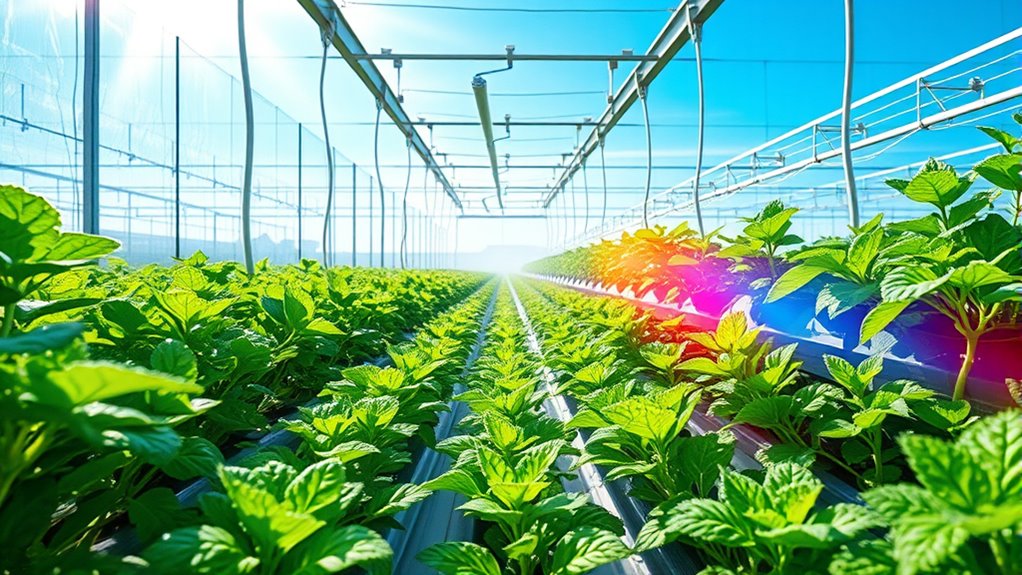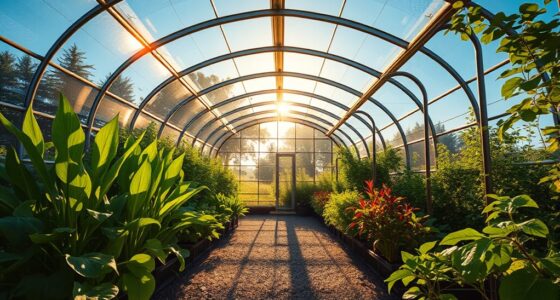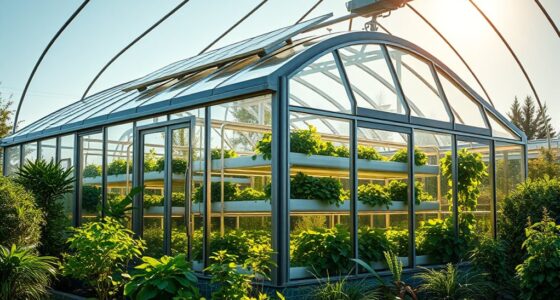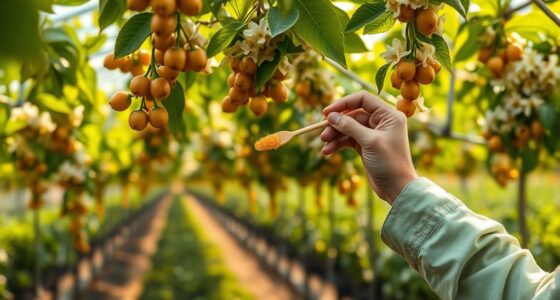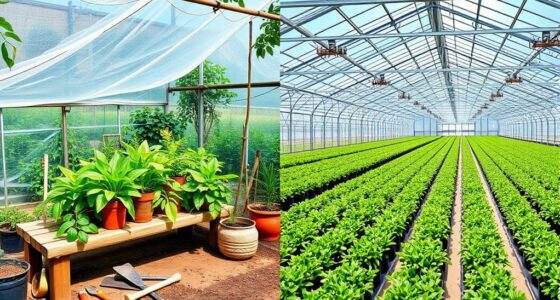Hydroponic greenhouses are revolutionizing sustainable farming by allowing you to grow plants without soil in controlled environments. This method conserves up to 90% of water compared to traditional agriculture and lets you cultivate crops year-round, regardless of climate. Benefits include higher yields, reduced pesticide usage, and ideal resource efficiency. However, challenges like initial costs and technical knowledge exist. Discover how this innovative approach can shape the future of food production and address pressing agricultural issues.
Key Takeaways
- Hydroponic greenhouses enable year-round cultivation, maximizing crop yields and ensuring food security regardless of external weather conditions.
- They utilize up to 90% less water than traditional farming, making them ideal for regions facing water scarcity.
- Advanced technologies in hydroponic systems, such as smart sensors and automated controls, enhance resource efficiency and reduce labor costs.
- Controlled environments in hydroponic greenhouses minimize pesticide use, resulting in healthier produce and improved crop health.
- Hydroponics supports urban agriculture, transforming limited spaces into productive farms and promoting local food accessibility.
The Concept of Hydroponics: Growing Without Soil

While traditional agriculture relies heavily on soil, hydroponics offers a revolutionary approach by allowing you to grow plants without it.
In hydroponics, plants thrive in nutrient-rich water, receiving essential nutrients directly through a water-based solution. This method enables you to control growth more precisely, making it possible to cultivate crops year-round, regardless of climate or season. Additionally, hydroponics can use water efficiency techniques that utilize up to 90% less water than traditional methods. Furthermore, the diversification of crops in hydroponic systems can lead to increased resilience against pests and diseases, enhancing overall productivity. Moreover, hydroponics can benefit from solar energy solutions, reducing reliance on grid electricity for artificial lighting and environmental controls. This innovative approach mirrors the principles of sustainable farming by minimizing waste and maximizing resource use.
Various systems, like Nutrient Film Technique or Ebb and Flow, provide unique ways to deliver nutrients. Key components include a balanced nutrient solution, artificial lighting for photosynthesis, and environmental controls to maintain ideal conditions.
Hydroponics not only conserves water but also supports sustainable farming practices, paving the way for innovations in agriculture and food production.
Benefits of Hydroponic Greenhouses
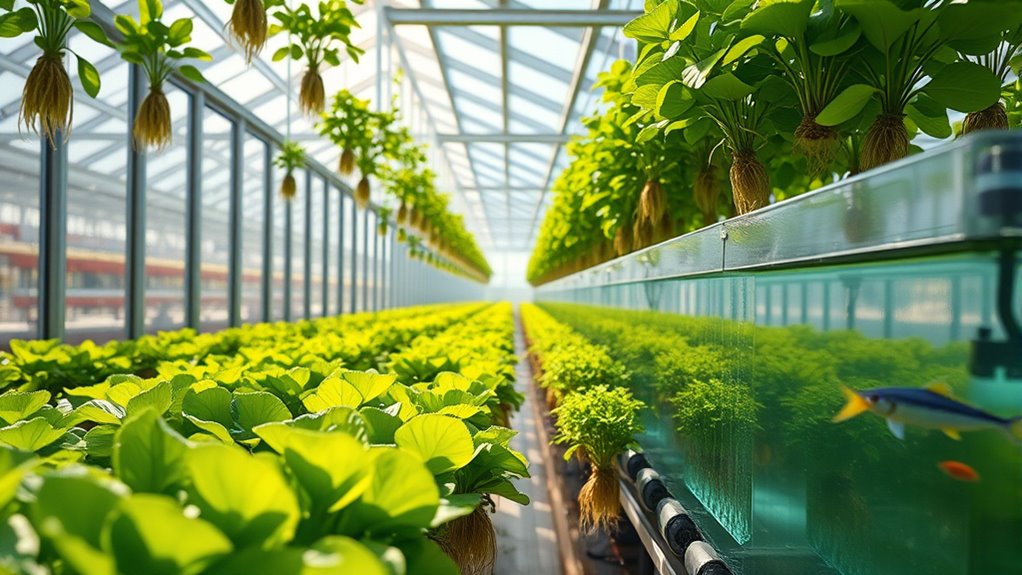
Hydroponic greenhouses offer numerous benefits that can transform the way you grow food.
First, they use up to 90% less water than traditional farming through efficient water use and recycling, making them perfect for areas with water scarcity. Additionally, hydroponics uses recirculated water solutions, which significantly reduces waste compared to conventional agriculture. This method aligns with the principles of emergency preparedness essentials, ensuring that resources are utilized effectively in times of need. Furthermore, the ability to cultivate diverse crops in a controlled environment enhances pollination efficiency and overall plant health. Hydroponic systems can also be designed to take advantage of space efficiency in urban areas, allowing for more food production in limited spaces.
Hydroponic greenhouses conserve water, using up to 90% less than traditional farming, making them ideal for water-scarce regions.
You'll also enjoy reduced pesticide needs, as the controlled environment minimizes pests, preserving soil health.
With faster growth rates and year-round production, you can achieve higher yields and better crop quality, ensuring consistent market supply.
Additionally, hydroponics maximizes space efficiency, making it ideal for urban settings.
Key Components of Hydroponic Systems
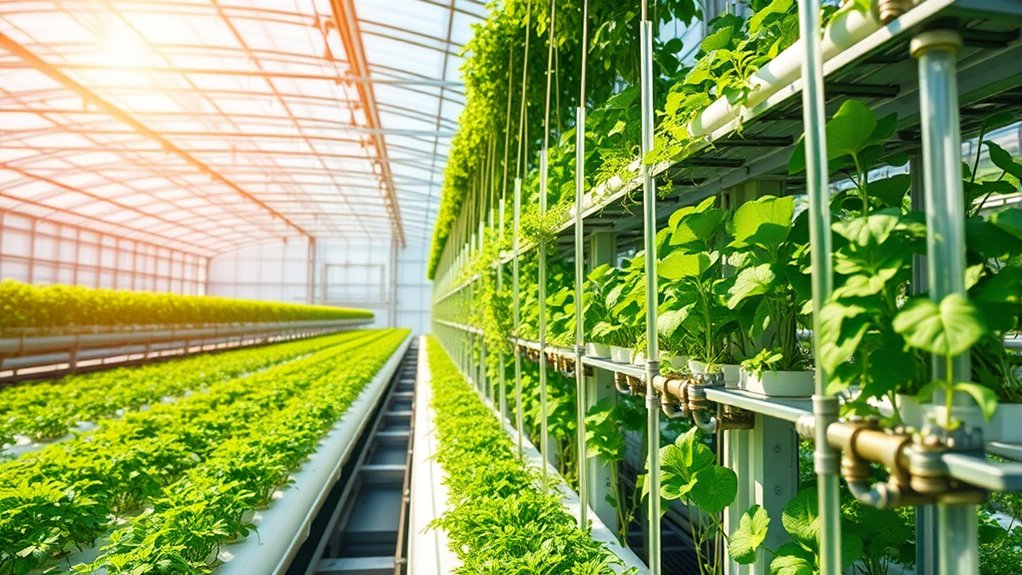
Five key components make up an efficient hydroponic system, each playing a crucial role in plant growth and health.
First, the growing medium, like rock wool or coconut coir, supports your plants. Additionally, nutrient solutions are crucial in hydroponics, as they provide essential minerals, ensuring robust growth. The careful management of state tax implications can also enhance the financial viability of investing in sustainable practices like hydroponics. Furthermore, maintaining color accuracy in the environment can help optimize plant health and productivity. A well-designed greenhouse can also significantly improve energy efficiency, making it easier to maintain optimal growing conditions.
Next, a nutrient solution provides essential minerals, ensuring robust growth. You'll also need a water delivery system, which includes pumps and irrigation techniques to consistently supply nutrients to the roots.
An effective lighting system, using LED or HID lamps, optimizes photosynthesis, especially in low-light conditions. Finally, climate control systems regulate temperature, humidity, and CO₂ levels, creating an ideal environment.
Exploring Different Hydroponic System Types

Understanding the various types of hydroponic systems is essential for optimizing your growing experience.
You can choose from liquid systems like Nutrient Film Technique (NFT) and Aeroponics, which rely on a continuous flow or misting of nutrients without solid mediums. Aggregate systems, on the other hand, use materials like rockwool or gravel to support roots. Hydroponics offers greater control over nutrient content, allowing growers to tailor solutions specifically to the needs of the plants. Additionally, using educational toys can enhance children's understanding of plant growth and sustainability through interactive learning experiences. Incorporating methods that promote fiber intake can also support plant health and yield. It's important to consider financial aid sources for those looking to invest in hydroponic systems as a long-term agricultural solution.
Decide between open systems, which don't recycle nutrient solutions, and closed systems that do. Additionally, passive methods like Wick Systems depend on capillary action, while active systems such as Drip Systems utilize pumps.
If you're short on space, consider vertical farming to stack plants and maximize yield. Each system has unique benefits tailored to different plants, so pick what aligns with your goals.
Advantages of Hydroponic Cultivation
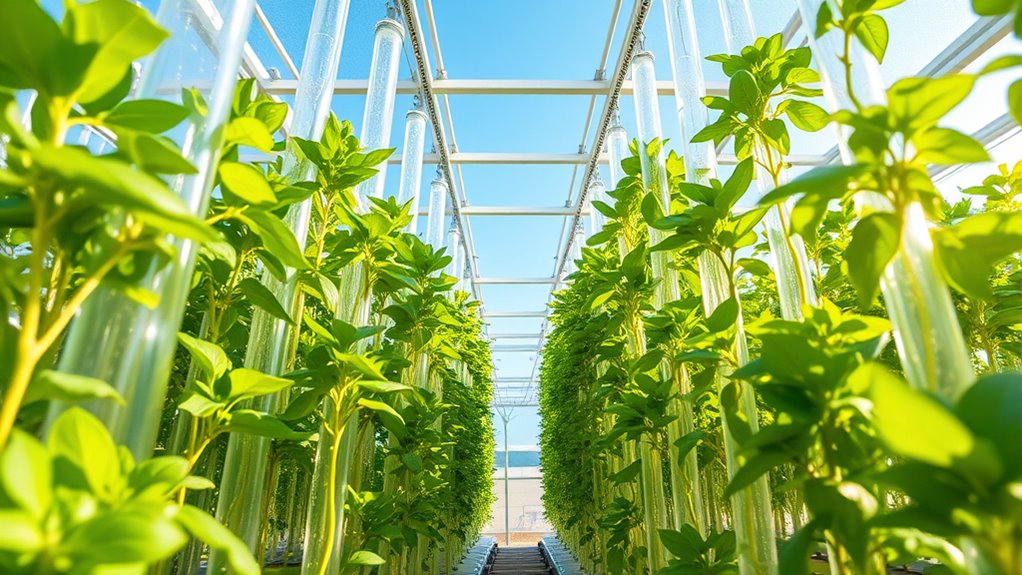
While traditional farming methods often struggle with resource limitations, hydroponic cultivation offers a multitude of advantages that can transform your growing experience.
You'll find that hydroponics uses about one-tenth of the water compared to conventional agriculture, making it ideal for regions facing water scarcity. Efficient water use not only conserves this precious resource but also allows for sustainable farming practices that can thrive in urban environments. Additionally, incorporating high omega-3 content from crops like chia seeds can enhance the nutritional value of hydroponically grown produce. Furthermore, utilizing backyard greenhouses can create the perfect environment for hydroponic systems, maximizing growth potential. Chia seeds' soluble fiber helps improve digestive health, making them a valuable addition to a balanced diet.
With higher plant densities, you can grow more crops in smaller spaces, perfect for urban settings. The controlled environment boosts crop yields, allowing for year-round cultivation without pests or extreme weather interference.
Hydroponics enables dense crop growth in limited spaces, ensuring year-round yields free from pests and weather challenges.
Plus, reduced reliance on pesticides and fertilizers means your produce is safer and healthier.
Embracing hydroponics not only supports sustainable practices but also conserves land and enhances food security, proving it's a revolutionary approach to modern agriculture.
Challenges and Limitations of Hydroponics

Despite the numerous advantages hydroponics offers, several challenges and limitations can hinder its widespread adoption.
First, the high initial costs and complex infrastructure can be a barrier, especially for small-scale growers. You'll need to invest in expensive equipment and technology, which can pose financial risks if the system doesn't deliver expected returns. Additionally, hydroponics relies heavily on a consistent power supply; outages can lead to crop losses. You'll also face a steep learning curve and need specialized knowledge for maintenance. Significant power supply is essential to ensure the smooth operation of hydroponic systems. Furthermore, understanding interest rates is crucial for growers when financing their setup to avoid excessive debt. Family caregiver contracts can also be beneficial in organizing financial responsibilities and ensuring fair compensation for any support you may require during the growing season.
Disease management is essential too, as waterborne diseases and pest infestations can quickly escalate in closed environments. Finally, limited crop diversity and ongoing debates about organic certification can affect market acceptance, making it challenging to succeed in this field.
Future Developments in Hydroponic Technology
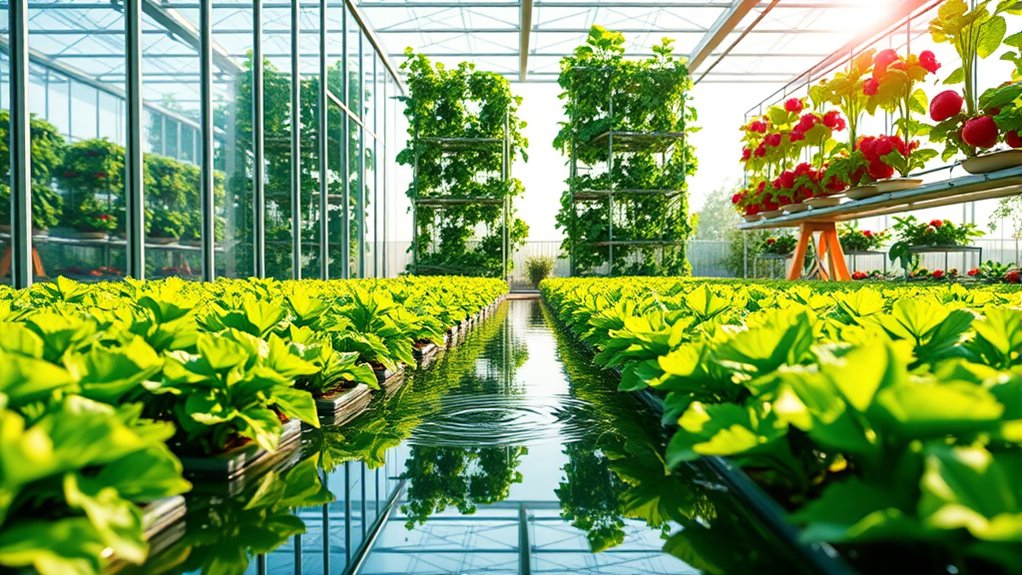
As hydroponic technology continues to evolve, growers can expect a wave of innovative developments that promise to enhance efficiency and sustainability. You'll notice increased automation in greenhouses, which will cut down on labor costs and boost productivity. Advanced LED lighting systems will optimize plant growth, while smart sensors will allow for real-time monitoring of vital factors like CO2 levels and humidity. Moreover, high productivity from hydroponics will allow growers to meet the rising demand for food in urban areas. Data analytics tools will refine nutrient delivery and pest management. Additionally, innovations in water conservation will enable you to use up to 90% less water than traditional farming. By incorporating geothermal energy, you can further reduce operational costs, making your hydroponic system not just efficient, but also environmentally friendly. The adoption of integrated pest management in hydroponics will also enhance crop health and yield. Furthermore, utilizing energy-efficient models in your hydroponic system can lead to significant cost savings over time. Embracing eco-friendly practices in hydroponics will ensure a sustainable future in agriculture!
Hydroponics and Urban Agriculture
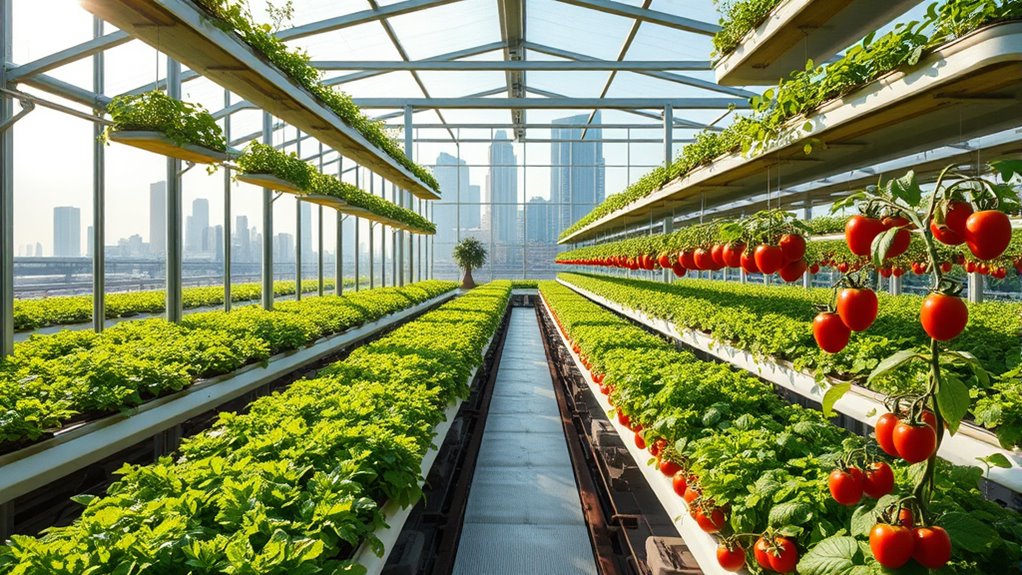
Hydroponics is transforming urban agriculture by utilizing limited space efficiently, enabling cities to grow fresh produce right where it's needed.
With vertical farming, you can maximize your urban area, converting rooftops and abandoned buildings into productive farms. This method allows for year-round crop production, making fresh food accessible regardless of the season. Additionally, hydroponics promotes local and zero-kilometre products, ensuring that communities have access to fresh produce grown in their own neighborhoods. Moreover, hydroponics can significantly reduce water consumption, using up to 90% less water than traditional farming, making it a sustainable choice. You'll also benefit from healthier produce with reduced pesticide use, enhancing food security in your community. Furthermore, hydroponic systems often yield higher nutrient retention in crops compared to conventional methods, ensuring that the produce is not only fresh but also nutritionally rich. The integration of hydroponics into urban areas also supports renewable energy solutions, further enhancing sustainability in food production.
As hydroponics integrates into urban planning, it opens up job opportunities and stimulates local economies, creating a vibrant, sustainable food system right at your doorstep.
The Role of Hydroponics in Sustainable Food Production

While conventional farming faces challenges like climate change and limited resources, hydroponics emerges as a powerful solution for sustainable food production. This innovative method uses nutrient-rich solutions instead of soil, offering a controlled environment that enhances crop quality and minimizes pesticide use. Hydroponics transcends limitations of traditional agriculture, such as soil erosion and water scarcity, providing a more resilient approach to farming. Additionally, hydroponics often employs advanced technologies that enable precise monitoring and automation, further improving efficiency and yield.
You'll appreciate how hydroponics conserves water, reducing consumption by up to 90% compared to traditional farming methods. With vertical farming capabilities, it optimizes space and allows for year-round crop production, regardless of weather conditions. Not only does hydroponics safeguard soil health and reduce environmental impact, but it also boosts crop yields and quality. By harnessing renewable energy and advanced technologies, hydroponics paves the way for a more sustainable and efficient agricultural future.
Frequently Asked Questions
What Initial Investments Are Needed for Starting a Hydroponic Greenhouse?
To start a hydroponic greenhouse, you'll need to invest in a polyhouse shelter, which can cost around Rs 6,00,000 for smaller setups.
You'll also require an NFT system, water and nutrient systems, and initial labor around Rs 10,000.
Don't forget miscellaneous equipment like pH and TDS meters.
Depending on your plans, make sure you have adequate space, as well as the right technology for temperature control and lighting to optimize growth.
How Do I Maintain the Nutrient Balance in a Hydroponic System?
Maintaining nutrient balance in a hydroponic system is like walking a tightrope; one misstep can lead to plant distress.
You'll want to regularly test nutrient concentrations using a PPM meter and adjust based on your plants' growth stages. Keep the pH between 5.5-6.5 for ideal nutrient absorption.
Monitor for signs of imbalance, and replace the nutrient solution every 1-2 weeks to guarantee your plants thrive without nutrient deficiencies or burns.
Can Hydroponics Be Used for All Types of Plants?
You can't grow all types of plants in hydroponics, but many thrive in this system.
Leafy greens and herbs like lettuce and basil are ideal due to their shallow roots.
Vegetables such as tomatoes and cucumbers work, too, though they need more space and support.
Root vegetables, like carrots, are less common since they require deeper soil.
Experimenting with different crops will help you find what works best for your setup.
What Are the Best Crops for Beginners in Hydroponics?
Did you know that hydroponic systems can increase crop yields by up to 30% compared to traditional methods?
If you're just starting with hydroponics, focus on leafy greens like lettuce and spinach, as they grow quickly and are easy to manage. Herbs such as basil and mint are also great choices.
Cherry tomatoes and compact strawberries provide rewarding fruits, while cucumbers add variety to your setup, making your hydroponic journey enjoyable and fruitful!
How Do I Troubleshoot Common Hydroponic System Issues?
To troubleshoot common hydroponic system issues, start by conducting regular inspections.
Check for system malfunctions, ensuring pumps and nozzles are operating correctly.
Monitor pH levels and nutrient solutions to prevent deficiencies.
Look for signs of pests or diseases and act quickly if you spot any.
Maintain proper temperature and lighting conditions, and keep a log of your observations.
Using automation and sensors can help streamline monitoring and enhance overall system efficiency.
Conclusion
To sum up, hydroponic greenhouses aren't just a trend; they're a crucial step toward sustainable farming. By harnessing technology, maximizing space, and reducing water usage, you can grow healthy food year-round while minimizing your environmental impact. Embracing hydroponics means embracing innovation, embracing efficiency, and embracing a future where food production is both sustainable and accessible. As we stand on the brink of this farming revolution, you have the opportunity to be part of a greener tomorrow.
